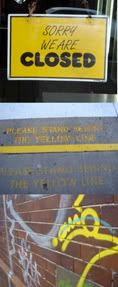Semi-Permanent Sydney 2007
Saturday, 31 March 2007 by galina
On Friday 30 March, i was lucky enough to have work pay for a day at Semi-Permanent!
Semi-Permanent is an annual design festival hosted by 'Design is Kinky'. It consists of a conference and exhibitions. Semi-Permanent inserts a flood of inspiration into the Australian design community bringing you face to face with world renowned artists and designers.
It was fantastic, and I have some notes I'm going to post here about some of the speakers on Monday, when i have access to internt again. Over all it was a great day, 6 speakers, not just graphic designers spoke, but illustrators, animators, typographers, painters...
The friday line up when something like this:
Sophie Howarth /Photography
TOKO /Graphic Design
Si Scott /Typography/Graphic Design
Tiffany Bozic /Painting/Illustration
James Jean /Illustration/Painting
Motion Theory /Music Videos/Film/Animation
TOKO were the best interms of presenting style and type of work. They were a young couple from Holland. Very funny!
Some quick notes I jotted down:
Dutch design (or even painting from way back: Mondrian) ... = Grids
Grids = actually means ANYTHING GOES!
Because structure needs humour.
"Holland actually looks like Sydney... if you close your eyes!"
The difference between coffee
In Holland you just ask for coffee and you get it.
In Australia, you need to identify:
1. Length (tall of short)
2. Colour (black or white)
3. Angle (flat or not)
"sometimes there's no time to think, just produce work."
creating you own typeface for a project, makes the artwork your own.
Het Zuidelijk Toneel is a Holland Theatregroup, they asked TOKO to come up with a "no-style" identity. ... they didn't know what they wanted! Something, basic, simple and straight forward. So TOKO didn't design a logo. Play titles and the name of the theatergroup are equally important and in print often overprinted.

the top 3 letters are always cut off, they are used effectively, "don't waste type!"
Si Scott:
Man, this guy couldn't speak to save himself! His work was absolutely amazing, and it’s incredible that he did it all by hand, but I think he had never spoken to so many people about his work before. Poor fellow was so nervous!

Tiffany Bozic:
"a riddle for the beginning of love
'good intensions'
a metaphor for the end of love"
"rules don't apply to my brushes", "guess-timating"
James Jean:
A composition should contain both a PUSH and PULL, between SMOOTHE and ROUGH = THUNDER and WIND














